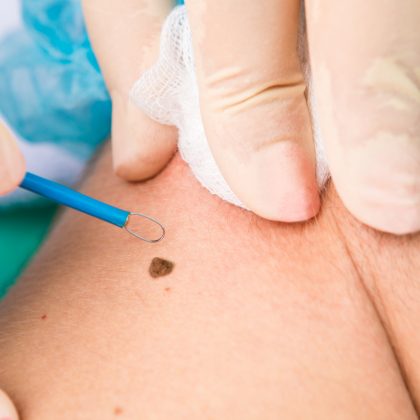
At The Skin Cancer Practice, we use Surgitron Radiofrequency Surgery to effectively remove raised benign moles, skin tags, seborrhoiec keratosis and other benign skin lesions. This technique is safe, effective and allows us to offer you superior cosmetic results when compared to conventional scalpel based surgery.
What is Surgitron?
Surgitron is a state of the art radiofrequency surgical device which uses ultra-high frequency radio wave technology that generate minimal heat – to precisely cut through skin tissues, allowing the removal of benign skin lesions on the face and body with minimal scarring. With Surgitron, only the skin lesion is removed leaving the surrounding skin untouched, therefore providing superior cosmetic outcomes with minimal to no downtime.
This technique offers a major advantage over conventional surgical excision, which usually results in an unsightly linear scar.
Advantages of Surgitron Radiofrequency Surgery
- Minimally invasive procedure
- Excellent cosmetic results – causes minimal scar tissue
- Minimal to no trauma to the surrounding normal skin
- Enhanced healing with significantly less bleeding, bruising, swelling and infection in comparison to scalpel incisions
- Fast recovery time with minimal to no downtime – can resume normal daily activities immediately
- Significantly less surgical risks compared to scalpel incisions ‘
- No stitches required
- Minimal aftercare required
What is the next step?
The first step is to book an appointment to have a consultation with one of our experienced doctors who will assess whether the lesion is clinically benign and suitable for treatment with radiofrequency surgery or not. The benefits and risks of the procedure will then be discussed with you and all your questions answered before you are booked for the procedure.
What skin lesions can treated with Surgitron?
Surgitron can be used to remove a number of benign skin lesions from both the face and body, such as:
- Benign raised moles (dermal naevi)
- Hairy moles
- Skin tags
- Seborrheic keratoses
- Dermatofibromas
- Sebaceous gland hyperplasia
What does Surgitron radiofrequency surgery involve?
Treatment begins by cleaning the skin lesion with an antiseptic solution first and then numbing the immediate area with a small amount of local anaesthetic to ensure your comfort during the procedure. Depending on the type skin lesion, part of it may be sent to pathology for analysis. A fine wire loop is then used to shave off the lesion, removing it layer at a time until it is level to the surrounding skin. We used a number of different sized probes to precisely target the unwanted skin lesion thereby avoiding trauma to the surrounding normal skin.
Post operatively, a silicone gel is applied directly to the wound to enhance healing and achieve a superior cosmetic outcome.
Generally you will be able to resume your normal day to day activities immediately after and minimal aftercare is required post op.
You will be advised to return for a routine follow up 6-8 weeks later.
What can I expect following treatment?
Following your procedure, you can expect to have a small superficial circular wound. During the healing process, we highly recommend applying a specific silicone gel daily for a period of 6 weeks so as to achieve optimal cosmetic results.
In the first few weeks, it is normal for the treated area to look pink and form a small scab. Once the skin has healed, the scab will lift off by itself and it is still normal for the area to still look pink for a few weeks. This will gradually fade away spontaneously with time and will eventually become a small flat pale scar.
Limiting sun and UV exposure to the treated area for a minimum of 3 months will also help to achieve a better cosmetic outcome. We highly recommend you wear an SPF 50+ sunscreen daily.
Are there any side effects?
Surgitron radiofrequency surgery is considered a minimally invasive procedure, however like any procedures there are still some potential risks and side effects. This includes redness, bruising, delayed healing, infection, scarring, pigmentation, and regrowth of the lesion.
If you have any related concerns post operatively, do not hesitate to reach out to us for advice and help.

